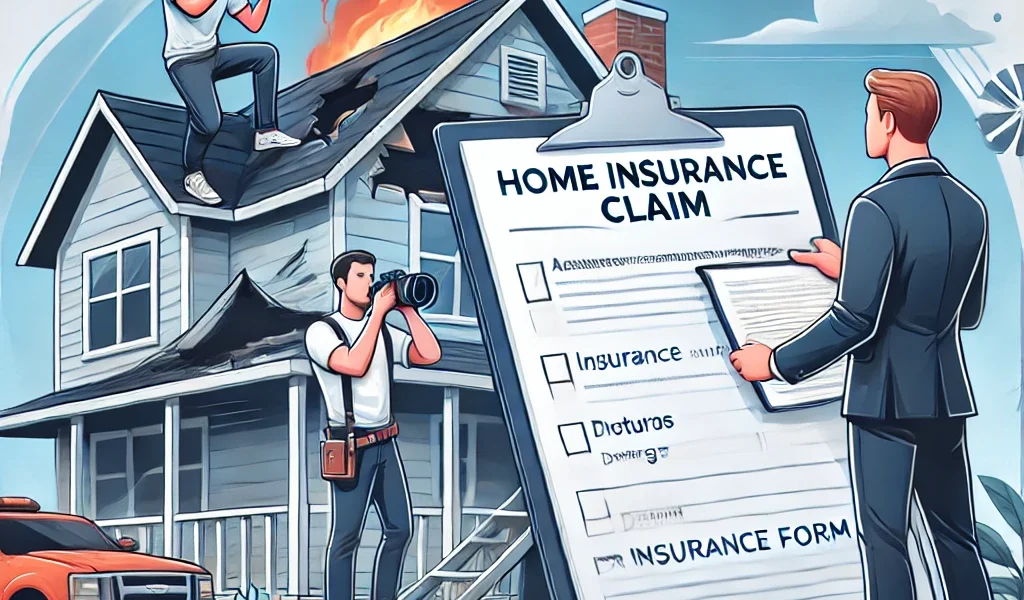Home is one of the most valuable assets for any individual or family. However, unexpected events such as natural disasters, fires, or theft can cause significant damage to your property. In such cases, home insurance plays a crucial role in providing financial relief.
But filing a home insurance claim can often seem overwhelming. If not handled properly, delays or denials may occur, making the process even more frustrating.
This DIY guide will help you understand what steps to take immediately after property damage, how to file an insurance claim, and how to maximize your claim settlement efficiently.
1. Immediate Steps to Take After Property Damage
When your home experiences damage, it’s crucial to act quickly while ensuring your safety.
Step 1: Ensure Safety First
- If the damage is due to fire, flooding, or a structural collapse, evacuate immediately.
- Contact emergency services (fire department, police, or medical assistance) if required.
- Avoid touching damaged areas until professionals assess the risk.
Step 2: Prevent Further Damage
- Temporary Repairs: Cover broken windows, leaks, or exposed areas with plastic sheets or tarps.
- Turn Off Utilities: If there’s electrical, gas, or water damage, switch off the main supply to prevent accidents.
- Keep Receipts: Any money spent on temporary repairs should be documented as part of the claim.
Step 3: Document the Damage
- Take Photos & Videos: Capture high-quality images and videos of all affected areas.
- Make a Detailed List: Note down damaged items, including furniture, electronics, and structural elements.
- Gather Proof of Ownership: Collect receipts, invoices, or previous photos of valuable belongings to strengthen your claim.
Step 4: Notify Your Insurance Provider
- Call your insurer or file a claim through their online portal.
- Provide an initial report describing the damage and affected areas.
- Ask about policy coverage, deductibles, and claim timelines.
2. How to File a Home Insurance Claim
To ensure a smooth claim process, follow these structured steps:
Step 1: Review Your Home Insurance Policy
Before proceeding, understand the coverage limits, deductibles, and exclusions stated in your policy.
Step 2: Submit a Claim Form
Most insurance companies require a detailed claim form. Fill it out carefully, ensuring accuracy to avoid delays.
Step 3: Schedule an Inspection
- The insurance company will assign an adjuster to assess the damage.
- Be present during the inspection and provide evidence of damage.
- Show the adjuster repair estimates from contractors for reference.
Step 4: Work With a Contractor
- Get multiple repair estimates from licensed contractors.
- Ensure the estimates cover labor, materials, and full restoration costs.
- Provide these estimates to the insurance company for better negotiation.
Step 5: Receive the Claim Settlement
- Once the claim is approved, you’ll receive the settlement amount.
- The insurer may release funds in installments, especially for large claims.
- If you have a mortgage, the lender may be involved in the claim payout process.
3. Common Reasons for Home Insurance Claim Denial
Insurance companies can deny claims for various reasons. Being aware of them helps in avoiding potential issues.
- Lack of Proper Documentation
- Missing receipts, photos, or reports can weaken your claim.
- Late Filing of Claim
- Most insurers have strict deadlines for claim submissions.
- Insufficient Coverage
- Some damages (e.g., flooding) may not be included in a standard home insurance policy.
- Pre-existing Damage
- Insurers may refuse claims if the damage is determined to be from wear and tear.
- Failure to Mitigate Further Damage
- Not taking temporary precautions may result in partial claim denial.
4. How to Maximize Your Home Insurance Claim Payout
To get the best possible compensation for your property damage, follow these expert tips:
- Provide a Thorough Damage Report: The more evidence you provide, the stronger your claim.
- Hire a Public Adjuster: If the settlement offer seems unfair, consider hiring a licensed public adjuster to reassess the damage.
- Negotiate with the Insurance Company: Insurers may initially offer a lower payout; don’t hesitate to negotiate.
- Be Aware of Depreciation Adjustments: Some policies cover actual cash value (ACV) instead of replacement cost, leading to lower settlements.
5. Frequently Asked Questions (FAQs)
Q1: How long does it take to process a home insurance claim?
The timeline varies depending on the severity of the damage and insurer policies. Typically, simple claims are processed within a few weeks, while complex claims may take several months.
Q2: Can I file a claim for minor damages?
Yes, but consider whether the damage exceeds your deductible amount. Filing frequent small claims can increase your insurance premium.
Q3: Will filing a claim affect my insurance rates?
In many cases, yes. A history of frequent claims may result in higher premiums.
Q4: What if my claim is unfairly denied?
You have the right to appeal the decision. Review the denial letter, provide additional evidence, and seek legal help if needed.
Q5: Does home insurance cover all natural disasters?
Not always. Standard policies may exclude damages from floods or earthquakes, requiring separate coverage.
Final Thoughts
Filing a home insurance claim doesn’t have to be stressful if you’re well-prepared. By taking immediate action, documenting the damage properly, and following the correct steps, you can maximize your claim payout without unnecessary delays or disputes.




